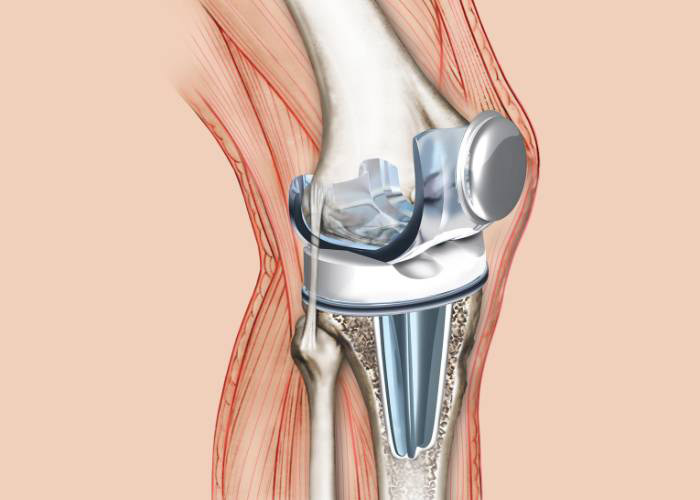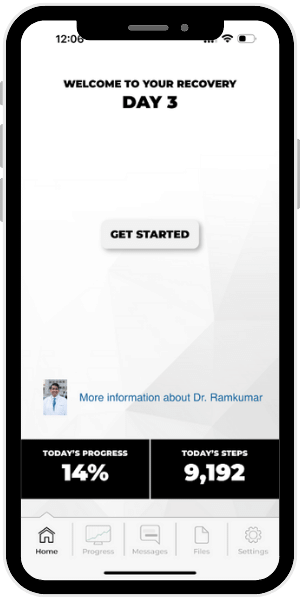Total Knee Revision Surgeon
Most patients who have a total knee replacement do not need any additional surgery. However, on occasion, the implant can wear out, or the patient may have issues that cannot be resolved without revision surgery. Revision knee replacement requires a surgeon with special expertise. Doctor Prem Ramkumar is specially trained to perform the revision knee replacement. He is is located in Long Beach and serves patients in Los Angeles, Orange County, and surrounding Southern California areas. Contact Dr. Ramkumar’s team today!

What is a revision total knee replacement?
Total knee replacement is meant to be the final, definitive operation for a knee with end-stage arthritis. The implants are designed to last a lifetime. Some say total knee implants can last 15 to 20 years, but the truth is we don’t really how long modern implants can truly last. There are many patients with older generation implants who are doing great 30 years later!
Unfortunately, sometimes these implants must be revised. Any subsequent operation to an initial total knee replacement is called a revision total knee replacement or knee revision. Some revision total knee replacements require only one implant to be removed and replaced, but in the majority of instances, implants in all three knee compartments – femoral, tibia, and plastic spacer – require revising. Sometimes, the bone around the knee needs rebuilding, and a longer stem is used for extra support in the setting of increased bone loss when extracting the prior implants. A revision total knee replacement is a complex procedure that takes longer than a primary (or initial) total knee replacement. The outcomes for revision total knee replacement are often less predictable and less successful than a well-functioning primary total knee replacement. Revision knee replacement requires a surgeon with special expertise. Dr. Prem Ramkumar is specially trained to perform the revision knee replacement. Dr. Prem Ramkumar, revision total knee replacement surgeon, is located in Long Beach and serves patients in Los Angeles, Orange County, and surrounding Southern California areas.

When is a revision total knee replacement necessary?
The leading cause for pain and disability after a primary total knee replacement is infection. It is necessary to rule out infection before considering other causes. This involves a blood test, known as a CRP and ESR. If positive, the next step is aspirating fluid from the knee to test the synovial fluid for signs of infection. Again, at the time of surgery, tissue is sent to the lab to rule out infection. Infection in the setting of a total knee replacement can be a very subtle presentation and warrants a systematic approach to addressing this. If the knee is found to be infected, the goal of the operation shifts from obtaining a fully functioning and pain-free knee to surviving and, secondarily, saving the leg. The mortality of a periprosthetic joint infection at 5 years is 26%. This carries a higher mortality than breast cancer, melanoma, bladder cancer, and melanoma. The treatment for a periprosthetic joint infection involves removing the implants, performing a thorough debridement, placing a temporary spacer, undergoing a minimum of 6 weeks of IV antibiotics, and replantation of new implants. Even after undergoing two operations and a period of antibiotics, the failure rate is nearly 30%.
If infection is ruled out, loosening or wear may be considered. This can be scrutinized with plain radiographs, a CT scan, or a bone scan. Depending on which implant is loose or worn, this should be revised to prevent a future catastrophic failure or fracture that would lead to a more challenging reconstruction for both the patient and Dr. Ramkumar.
Instability may also be another cause of failure. This can present early after the primary (initial) replacement or late. This results in a lack of trust in the knee that results in a sensation of giving out or imbalance. This is diagnosed often on exam and with scrutiny of radiographs.
Stiffness is one of the least satisfying reasons to revise a primary total knee replacement, for both the patient and Dr. Ramkumar. Revision for stiffness requires a realistic expectation setting. Scar tissue can be removed during an operation, but it can always return. Knowing which patients will benefit from a revision for stiffness is highly unpredictable and is often a product of the range of motion the patient had before undergoing a knee replacement.
Fracture is a common reason to revise a total knee replacement. This often occurs in older and more frail populations. Sometimes, the treatment may be a plate and screws whereas in other cases it may be revising the existing total knee replacement and putting in a bigger prosthesis with more constraint. Increased constraint limits cutting and pivoting but provides a functional knee for activities of daily living.
What is the recovery process after a revision total knee replacement?
Patients commonly spend at least a night in the hospital. If the revision is for infection, plan to spend at least 3-4 nights to identify the correct antibiotic regimen and establish a PICC line to deliver the medications outside the hospital setting. You will be sent home with crutches or a walker and given specific instructions to reduce pain and swelling. Weight-bearing is encouraged immediately after surgery, and you should be able to walk without any assistance within a few weeks. Dr. Ramkumar will recommend physical therapy to help you regain strength and restore mobility.


